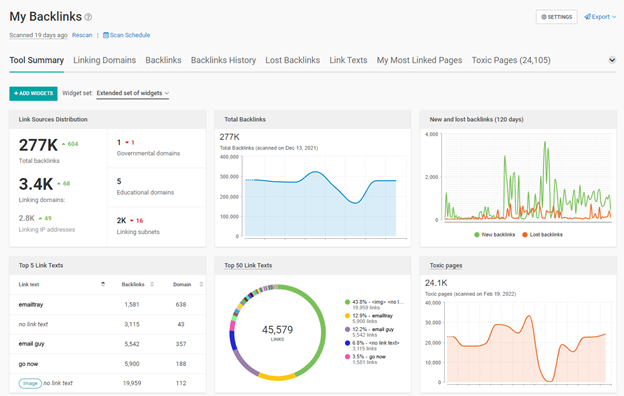Toxic Backlinks

How to Identify and Remove Toxic Backlinks;
Toxic Backlinks – Link building, if done correctly, can be an exhausting process of creating quality content that gets shared organically across the web. It’s no surprise that various link building schemes have sprung up over the years to beat the system and make this process easier. The same system, however, fights back, constantly reminding us to focus on quality rather than quantity.
Google recently issued a reminder about eligible links and announced a new spammy backlink algorithm update. This article explains the steps to perform a successful backlink audit to help you identify toxic backlinks. We’ll also list ways to find out which of the bad backlinks are hurting your rankings and the best tactics to get rid of them:
What are toxic backlinks?
Website owners are often blinded by wanting more instead of having the best quality. Although in theory, every backlink you get is a vote of confidence in your site, links from high domain rank sites will give the best results. So, those 1,000 backlinks you just got from Fiverr for $4?
Yeah, maybe that wasn’t the best idea. Links from low authority or spammy sites can not only be useless, they can also hurt your ranking in the long run or lead to search engine penalties. The possibilities of getting toxic backlinks are endless.
This can happen organically, spammy backlinks can be the result of previous ill-informed backlink building efforts or black hat SEO attempts by your competitors.
Building backlinks is an ever-changing topic, so backlinks earned years ago may not follow the latest industry practices. If you’re working with a business or using tactics that haven’t tracked recently published information on the topic, don’t be surprised that after the latest update to Google’s spam backlink algorithm, your ranking may drop.
anchor text
In an ideal world, you would want backlinks to have different anchor text pointing to your site. Moreover from brand mentions, specific keywords, bare links, images, etc. In most cases, you will see exactly that. However, sometimes the anchors themselves can give you a warning and help you identify spammy backlinks.
For example, you may notice that some backlinks pointing to your site use anchor text that is not aligned with your business. During a backlink audit for a client, we discovered that similar low-quality sites were linking to one of the websites using anchor text files.
Since it seemed like an anchor text that didn’t fit this particular business model, we analyzed it and found a lot of spam backlinks from adult sites. A good rule of thumb is to always look for inconsistencies in the anchor text and investigate.
These metrics may not be enough to recognize bad links, but it’s a good starting point. Google itself identifies more specific link patterns, showing webmasters which backlinks will negatively affect a site’s ranking in search results. Some of these tactics include paid backlink building, excessive link exchanges, automated link building services, and unnatural link building.
The impact of toxic links
Since 2012, when the Google Penguin algorithm update was released, manipulative link building tactics are no longer so common. Not only has Google added more human resources to its spam team that can manually penalize sites that have toxic backlinks, but the algorithms have evolved and improved to recognize spam. Let’s look at a few scenarios on how bad backlink building practices can affect your site:
1. Unnatural links are ignored. – Creating useless links that are not approved by Google can be a waste of time and resources. These links will have no effect on your organic traffic. Moreover as search engines will recognize these backlinks but completely ignore them. On the plus side, if you somehow get those bad links without consent. Hence you might be able to avoid Google’s algorithmic penalties.
2. Unnatural links are penalized. – The Penguin algorithm can be triggered primarily by two things: link schemes and keyword stuffing. Once you have received this penalty. You will see a big and drastic drop in organic traffic and sometimes visibility as well. Penalties can be difficult to notice if only a few URLs are affected at a time.
3. Unnatural links receive a manual action. – Although manual actions are not as common these days, there are still unicorns in the link building universe. Especially if you are a repeat offender. Google issues a manual action against a site when a member of Google’s web spam compliance team reviews its link profile and finds a bunch of unnatural links. Manual review can be triggered by an algorithm or even by your competitor reporting it, ie submitting a spam report.
How do you know if you’ve been hit?
A manual action penalty is almost impossible to miss because the affected pages or even the entire website will suffer a quick and painful drop in search rankings or disappear from search results altogether. In this case, you will also receive a notification from Google Search Console and you will be able to see the problem in the manual action report by expanding the description with the affected URLs.
You can most likely fix the issues by following the guidelines and asking Google to review your site. Unfortunately, link-related reconsideration requests can take forever, so it’s best to act quickly, not when the entire site has been affected.
If you see a green tick under the manual action report, you’re free! Celebrate, be careful and check your site’s backlinks to avoid problems in the future. You may see a similar drop in traffic when your page receives a Penguin penalty. Since Penguin is a page-specific update, you’ll notice a big drop for specific keywords, but it can also affect larger sections of your website.
Either way, the recovery process will be long and difficult. You should stop using all the harmful tactics that caused these problems. In the first place and reject the links that seem to be the prime suspects in wreaking havoc. Hope for the best, but be prepared that the landing page may never fully recover as it was previously blocked by bad links. Creating toxic backlinks is a quick fix. This may take more time and patience, but it definitely pays off to try and recover from a penalty.
Audit to find toxic links
A backlink audit allows you to check if the site is in good condition and make sure there are no spammy backlinks. Hence that could get in the way of future SEO efforts. Also, when you take a close look at your site’s backlinks, you quickly realize how powerful a good link profile is. You’ll see where you can get more high-value links that will improve your site’s performance and ranking.
Start by getting an idea of your competitors’ backlink strategies before you start your audit. Which is crucial to knowing where you stand. You’ll get valuable information that you can use as a reference to understand your own site’s link profile. Next, check your backlink profile using the Ahrefs backlink profile overview or similar tools. Look for inconsistencies and keep an eye out for big spikes and drops in your referring domains report.
It can also be useful to check where your links are coming from. If you see a lot of links from countries where you don’t do business, there may be a problem. For example, if you get a lot of backlinks from the .xxx top level domain name, but you don’t work in the adult industry, that’s a clear sign that you may have toxic backlinks. There is no one-size-fits-all approach here, it must be tailored to each business individually.
Correct and improve your backlink profile
If you notice that some links you created years ago don’t comply with the new rules. Moreover remove the ones you have control over.
As with others, Google suggests that you manually contact webmasters and ask them to remove backlinks. The chances of doing so are slim, but it doesn’t hurt to ask. You can also remove bad links using a disavow file. The Disavow file tells Google which links should not be considered. However, only take these actions if you have a significant number of spam, unnatural, or low-quality links pointing to your site that could or have already caused manual action.
Should we disavow toxic links?
Although the Google Disavow file is often mentioned as a last resort. Sometimes it will be your only option to solve the problem of toxic links. If you have too many spammy links, you probably won’t be able to remove them by asking about them in a polite email. You may not even be able to remove links you created yourself due to lost passwords or down sites.
Q&A
How bad are toxic backlinks?
Even a no-follow link from a powerful site can boost your rankings. At the other end of the spectrum, links from the low authority side, or “spam” sites, may not help your ranking. Toxic backlinks can not only hurt your rankings, they can also lead to search engine penalties.
What is a toxic URL?
Toxic backlinks usually show signs of poor quality or an attempt to manipulate rankings, such as: From sites that were created solely for the purpose of generating links. From sites and content that are not thematically relevant. From sites not indexed by Google.
Should I remove toxic backlinks?
Your website is likely to experience a massive drop in search engine rankings and even be banned entirely by Google. This can be detrimental to your business growth and forces you to remove bad backlinks coming to your site.
Does Google ignore bad links?
However, Google tends to ignore and often no longer actively penalizes spammy links. Previously, however, yes, Google imposed a massive penalty on sites that accumulated a large number of malicious or manipulative links. However, in Penguin 4.0, Google will generally ignore bad links.
What are low quality backlinks?
Another common characteristic of low-quality backlinks is that they come from low-traffic, low-engagement websites. Links from low-traffic sites are unlikely to be seen by users, so they generally don’t add much value to your website.


